MP Board Class 12th Chemistry Solutions Chapter 16 Chemistry in Everyday Life
Chemistry in Everyday Life NCERT Intext Exercises
Question 1.
Sleeping pills are recommended by doctors to the patients suffering from sleeplessness but it is not advisable to take its doses without consultation with the doctor. Why ?
Answer:
Sleeping pills contain drugs that may be tranquilizers or anti-depressant. They affect the nervous system, relieve anxiety, stress, irritability or excitement. But they should strictly be used under the supervision of a doctor. If not, the uncontrolled and overdose can cause harm to the body and mind because in higher doses, these drugs act as poisons.
Question 2.
With reference to which classification has the statement, “ranitidine is an antacid” been given ?
Answer:
This statement refers to the classification of drugs according to pharmacological effects of the drugs because any drug which is used to neutralise the excess acid present in the stomach will be called an antacid and ranitidine prevents the interaction of histamine with the receptors present in the stomach wall. Histamine stimulates the secretion of pepsin and HCl in the stomach.
Question 3.
Why do we require artificial sweetening agents ?
Answer:
To reduce calorie intake and to protect teeth from decaying, we need artificial sweeteners.
![]()
Question 4.
Write the chemical equation for preparing sodium soap from glyceryl oleate and glyceryl palmitate. Structural formulae of these compounds are given below:
(i) (C15H31COO)3C3H5 – Glyceryl palmitate
(ii) (C17H32COO)3C3H5 – Glyceryl oleate
Answer:
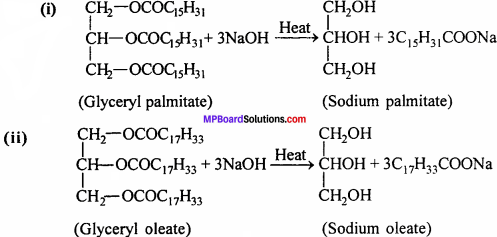
Question 5.
Following type of non-ionic detergents are present in liquid detergents, emulsifying agents and wetting agents. Label the hydrophilic and hydrophobic parts in the molecule. Identify the functional group(s) present in the molecule.

Answer:

Chemistry in Everyday Life NCERT Text-Book Exercises
Question 1.
Why do we need to classify drugs in different ways ?
Answer:
Drugs have been classified in different ways depending
- upon their pharma – cological effect
- upon their action on a particular biochemical process
- on the basis of their chemical structure
- on the basis of molecular targets.
For example, classification of the drugs based on pharmacological effect is useful for doctors. The classification of drugs based on molecular targets is the most useful classification for medicinal chemists. Thus, drugs are classified in different ways to serve different purposes.
Question 2.
Explain the term, target molecules or drug targets as used in medicinal chemistry.
Answer:
Drugs taken by a patient interact with macro molecules such as proteins, carbo – hydrates, lipids and nucleic acids and these are called drug targets. These macro molecules or drug targets are known to perform several role in the body.The drugs are designed to interact with specific targets so that these have least chances of effecting the other targets. This minimises the side effects and localises the action of the drug.
Question 3.
Name the macro molecules that are chosen as drug targets.
Answer:
The macro molecules that are chosen as drug targets are carbohydrates, proteins, lipids and nucleic acids.
Question 4.
Why should not medicines be taken without consulting doctors ?
Answer:
The drugs or medicines have side effects also. These side effects arise because the drug may bind to more than one type of receptor. Further their wrong choice and over dose can cause havoc and even may cause death. Therefore, it is must that the medicines should not be given without consulting doctors.
Question 5.
Define the term chemotherapy.
Answer:
The branch of chemistry which deals with the treatment of diseases using chemicals is called chemotherapy.
![]()
Question 6.
Which forces are involved in holding the drugs to the active site of enzymes ?
Answer:
The forces holding drugs to the active sites of enzymes are hydrogen bonding, ionic bonding, dipole-dipole interactions or van derwaals’ forces.
Question 7.
While antacids and anti-allergic drugs interfere with the function of histamines, why do these not interfere with the function of each other ?
Answer:
They do not interfere with the functioning of each other because they work on different receptors in the body. Secretion of histamine causes allergy and acidity while antacid removes only acidity.
Question 8.
Low level of nor – adrenaline is the cause of depression. What type of drugs I are needed to cure this problem ? Name two drugs.
Answer:
Nor-adrenaline induces a feeling of well being and helps in changing the mood. If the level of nor adrenaline is low, then the signal sending activity of the hormone becomes low and the person suffers from depression. In such cases, the patient needs anti depressant drugs which inhibit the enzymes which catalyses the degradation of nor adrena-line. The common drugs used as anti-depressant are iproniazid and phenelzine.
Question 9.
What is meant by the term ‘broad spectrum antibiotics’ ? Explain.
Answer:
The range of bacteria’s or other micro-organisms that are affected by a certain antibiotic is expressed as its spectrum of action. The term broad spectrum antibiotics means an antibiotic which kills or inhibits a wide range of Gram-negative and Gram-positive bacteria.
Question 10.
How do antiseptics differ from disinfectants ? Give one example of each
Answer:
1. Antiseptics are applied to living tissues such as wounds, cuts etc. to kill or prevent the growth of micro – organisms.
Example:
0-2% phenol, tincture iodine, dettol etc.
2. Disinfectants are applied to inanimate (or nonliving) objects such as floors, instrution Disinfectants are applied to inanimate (or nonliving) objects such as floors, instru-ments, drainage system etc.
Example:
1% solution of phenol, chlorine (0-2 to 0-4 ppm) SO2 in low concentration.
![]()
Question 11.
Why are cimetidine and ranitidine better antacids than sodium hydrogen-carbonate or magnesium or aluminium hydroxide ?
Answer:
Antacids NaHCO3, Mg(OH)2 or Al(OH)3 neutralize the excess acid produced in the stomach but their prolonged use can cause the production of excess acid in the stomach, which is harmful and may result in ulcers. It means these drugs control only symptoms. Cimetidine and ranitidine work without such side effect (because they control the cause) as they prevent interaction of histamine with the receptors of the stomach wall as histamine stimulates the secretion of acid. Thus, these are better antacids than, NaHCO3, Mg(OH)2 or Al(OH)3.
Question 12.
Name a substance which can be used as an antiseptic as well as disinfectant.
Answer:
Phenol is a substance which can be used as an antiseptic (0 – 2% solution) as well as disinfectant (1% solution).
Question 13.
What are the main constituents of dettol ?
Answer:
Dettol is a mixture of chloroxylenol and terpineol.
![]()
Question 14.
What is tincture of iodine ? What is its use ?
Answer:
In Chemistry, a tincture is a solution that has alcohol as its solvent. Tincture iodine is 2 – 3% solution of iodine in alcohol-water mixture. It is applied on wounds to either kill or prevent the growth of micro organisms.
Question 15.
What are food preservatives ?
Answer:
Chemical substances which are used to protect the food against bacteria, yeasts and moulds are called food preservatives e.g., sodium metabisulphite, sodium benzoate.
Question 16.
Why is use of aspartame limited to cold foods and soft drinks ?
Answer:
Use of aspartame is limited to cold foods and soft drinks because it is unstable at cooking temperature.
Question 17.
What are artificial sweetening agents ? Give two examples.
Answer:
Artificial sweetening agents are the substances produced wholly or partially by chemical synthesis, which are added to food to impart sweet taste.
Example:
- Sucrose
- Saccharin.
Question 18.
Name the sweetening agent used in the preparation of sweets for a diabetic patient.
Answer:
Any artificial sweetening agents such as saccharin, aspartame or alitame may be added.
![]()
Question 19.
What problem arises in using alitame as artificial sweetener ?
Answer:
Alitame is a high potency artificial sweetener, which has 2000 times sweeteners value in Comparison to cane sugar. Thus, the control of sweetness of food is difficult while using it.
Question 20.
How are synthetic detergents better than soaps ?
Answer:
- Soaps cannot be used in hard water but detergents can be used.
- Soaps cannot be used in acidic water but detergents can be used.
Question 21.
Explain the following terms with suitable examples
(a) Cationic detergents
(b) Anionic detergents and
(c) Non-ionic detergents.
Answer:
(a) Cationic detergents are those which have cationic hydrophilic group. These are mostly acetates, chlorides or bromides of quaternary ammonium salts. For example cetyltrimethyl ammonium chloride.
[CH3(CH2)15 N(CH3)3]+Çl–
(b) Anionic detergents are those which have anionic hydrophilic group. These are of two types:
(i) Sodium alkyl sulphate e.g., sodium lauryl sulphate CH3(CH2)10CH2OSO3–Na+
(ii) Sodium alkyl benzene sulphonate e.g., sodium 4-(l-dodecyl) benzene sulpho- nate (SDS)
(c) Non-ionic or neutral detergents are esters of high molecular mass alcohols as in fatty acids. For example, polyethylene glycol stearate.
![]()
(c) Non-ionic or neutral detergents are esters of high molecular mass alcohols as in fatty acids. For example, polyethylene glycol stearate.
CH3(CH2)16COO(CH2CH2O)nCH2CH2OH
Polyethylene glycol stearate.
Question 22.
What are bio-degradable and non-biodegra-dable detergents ? Give one example of each.
Answer:
Bio-degradable detergents are degraded by bacteria. In them, hydrocarbon chain is unbranded. They do not cause water pollution and are bitter. Example: Sodium lauryl sulphate.
Non-biodegradable detergents possess highly branched hydrocarbon chain so bacteria cannot degrade them easily. They cause water pollution. Example: Sodium 4-(l, 3, 5, 7-tetramethyl-actyl) benzene sulphonate.
![]()
Question 23.
Why do soaps not work in hard water ?
Answer:
Hard water contains calcium and magnesium salts. Therefore, in hard water, soaps get precipitated as insoluble calcium and magnesium soaps which being insoluble stick to the cloth as gummy mass and blocks the ability of soap to move oil or grease from the cloth.
Question 24.
Can you use soaps and synthetic detergents to check the hardness of water ?
Answer:
Soaps can be used to check the hardness of water as they give insoluble precipitates of calcium and magnesium soaps in hard water but synthetic detergents do not give precipitate, so they can not check the hardness of water.
Question 25.
Explain the cleansing action of soaps.
Answer:
Cleaning action of soaps:
Cleaning action of soap and detergents are based on miceller activity. Soaps are sodium salt of higher fatty acids e.g., sodium stearate which ionises as:
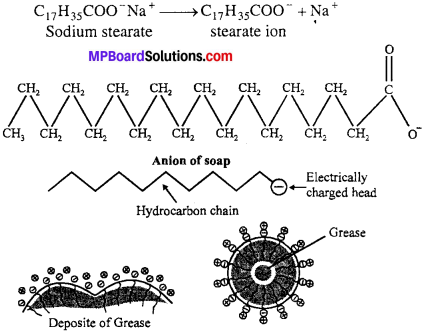
The anionic head of stearate ion (- COO–) is hydrophilic and hence has great affinity for water. The hydrocarbon part is hydrophobic and has great affinity for oil, grease etc.
When soap dissolves in water the anions (C17H35COO–) form micelle encapsulating oil or grease inside. These micelles are removed by rinsing with water. Thus the main function of soap is to convert oily and greasy dirt to colloidal particles by forming an emulsion. Soaps therefore, act as emulsifying agents. This mechanism of cleaning is also applicable to synthetic detergents like sodium lauryl sulphate CH3(CH2)11 SO–4 Na+. Repulsion of similar charge -COO– or -SO–4 covering each oil (grease) micelle prevents them to come together. Thus oil or grease remains in the suspension.
Question 26.
If water contains dissolved calcium hydrogen carbonate, out of soaps and synthetic detergents which one will you use for cleaning clothes ?
Answer:
Calcium bicarbonate makes water hard. Soap will give precipitate with this hard water and therefore, cannot be used for cleaning clothes. On the other hand, a synthetic detergents does not give precipitate in hard water because its calcium salt is also soluble in water. Therefore, synthetic detergents can be used for cleaning clothes in hard water.
![]()
Question 27.
Label the hydrophilic and hydrophobic parts in the following compounds:
(a) CH3(CH2)10CH2OSO3– Na+
(b) CH3(CH2)15\(\overset { + }{ N } \)(CH3)3\(\overset { – }{ Br } \)
(c) CH3(CH2)16COO(CH2CH2O)nCH2CH2OH
Answer:
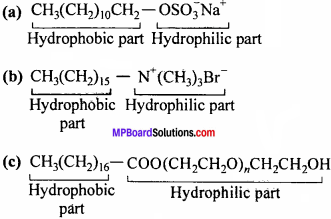
![]()
Chemistry in Everyday Life Other Important Exercises
Chemistry in Everyday Life Objective Type Questions
Question 1.
Choose the correct answer:
Question 1.
Which isomer of cyclohexane hexachloride is a strong insecticide:
(a) α
(b) β
(c) γ
(d) δ
Answer:
(c) γ
Question 2.
Denatured spirit is specially used:
(a) In medicine
(b) In fuel
(c) In varnish
(d) In propellant.
Answer:
(a) In medicine
Question 3.
Which of the following is not an example of analgesic:
(a) Phenacetin
(b) Paracetamol
(c) Chloramphenicol
(d) Morphine.
Answer:
(c) Chloramphenicol
Question 4.
Which of the following medicine was discovered by Alexander Fleming:
(a) Penicillin
(b) Streptomycin
(c) Chloromycetin
(d) Aspirin.
Answer:
(a) Penicillin
Quention 5.
Which medicine is used for the treatment of tuberculosis:
(a) Penicillin
(b) Streptomycin
(c) Chloromycetin
(d) Sulphadiazine.
Answer:
(b) Streptomycin
![]()
Question 6.
Which medicine is used for the treatement of T.B.:
(a) Pencillin
(b) Aspirin
(c) Chloramphenicol
(d) Streptomycin.
Answer:
(d) Streptomycin.
Question 7.
Saccharin is times sweeter than sugarcane:
(a) 10
(b) 600
(c) 4000
(d) 40.
Answer:
(b) 600
Question 8.
The chemical substance extracted from Rauvolfia serpentina is:
(a) Aspirin
(b) Quinone
(c) Bithionol
(d) Reserpine.
Answer:
(d) Reserpine.
Question 9.
Compound which is used both as an antipyretic as well as analgesic is:
(a) Phenacetin
(b) Sulpha drug
(c) Paracetamol
(d) Aspirin.
Answer:
(d) Aspirin.
Question 10.
Which of the following group expresses maximum number of detergent:
(a) Cationic
(b) Anionic
(c) Non-ionic
(d) Hydrophobic.
Answer:
(b) Anionic
![]()
Question 11.
Which of the following is a tranquillizer:
(a) Seconol
(b) Streptomycin
(c) Morphine
(d) Phenacetin.
Answer:
(a) Seconol
Question 12.
Which of the following is not an antibiotic:
(a) Terramycin
(b) Chloromycetin
(c) Morphine Salol is
(d) D-Penicillin.
Answer:
(c) Morphine Salol is
Question 13.
Salol is used as:
(a) Antipyretic
(b) Antipyretic
(c) (a) And (b) both
(d) None of these
Answer:
(c) (a) And (b) both
Question 14.
Chloroquine is an example of:
(a) Antipyretic
(b) Antimalarial
(c) Antibacterial
(d) Antituberculor.
Answer:
(b) Antimalarial
Question 15.
Which of the following is a broad spectrum antibiotic:
(a) Streptomycin
(b) Penicillin
(c) Ampicillin
(d) Chioramphenicol.
Answer:
(d) Chioramphenicol.
![]()
Question 16.
Which of the following is not an antibiotic:
(a) Terramycin
(b) Chioromycetin
(c) Morphine
(d) Penicillamine.
Answer:
(c) Morphine
Quesrtion 17.
Veronal is used as:
(a) Anaesthetic
(b) Sedative
(c) Antiseptic
(d) None of these.
Answer:
(b) Sedative
Question 18.
Which of the following ¡s a hypnotic:
(a) Lurninol
(b) Salol
(c) Catechol
(d) Phenol.
Answer:
(a) Lurninol
Question 19.
Pheromones are secreted by:
(a) Endocrine glands
(b) Stomach
(c) Exocrine glands
(d) Sex glands.
Answer:
(c) Exocrine glands
![]()
Question 2.
Fill in the blanks:
- Oil of …………. is used as medicine.
- Sodium benzoate and potassium metabisulphate are good ………….
- Sodium dodecyl benzene sulphonate and sodium lauryl sarcosinate are important ………….
- Iodine is a strong ………….
- Example of a tranquilizer medicine is ………….
- …………. is obtained from cinchona bark.
- Chloroquine is a …………. medicine.
- …………. is known as father of surgery.
- Alexander Fleming discovered …………. antibiotic medicine.
- Substance which reduces the acidity of stomach is called ………….
Answer:
- Cinnamon
- Preservative
- Detergent
- Antiseptic
- Seconal
- Quinine
- Antimalarial
- Sushrut
- Penicillin
- Antacid.
![]()
Question 3.
Match the following:
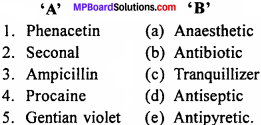
Answer:
- (e) Antipyretic.
- (c) Tranquillizer
- (b) Antibiotic
- (a) Anaesthetic
- (d) Antiseptic
Question 4.
Answer in one word / sentence:
- What are pain reliever medicine called ?
- Write name of two analgesic.
- Name a suitable chemical for excessive tension and mental disorders.
- Streptomycin medicine is used for the treatment of which disease ?
- Why are antifertility drugs used ?
Answer:
- Analgesic
- Aspirin and Morphine
- Equanil
- Malaria
- For birth control or control of reproductive ability
![]()
Chemistry in Everyday Life Short Answer Type Questions
Question 1.
What are germicides ?
Answer:
Germicides are substances which possess the power to destroy germs. Sulphur compounds, mercury com-pounds (mercuric iodide) and phenolic compounds are usedas germicides. Sulphur compounds in soap protect the skin from pimples, dandruff and skin infection. Phenolic compounds are mostly used as germicides. Cresyclic acid which is a mix-ture of m-cresol and p-cresol is mixed in soap as a germicide.
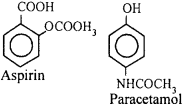
Question 2.
Write the structure of chloramphenicol and state its use.
Answer:
Chloramphenicol is an effective antibiotic. It is mainly used in typhoid, fever, diarrhoea, cough, meningitis and urinary diseases.

Question 3.
What do you understand by antipyretics ?
Answer:
These are used to lower down the body temperature in high fever. These drugs are used both as antipyretic and as analgesic, e.g., aspirin (acetylsalicylic acid), parace-tamol (4-acetamido phenol), phenacetin (4-ethoxy acetanilide), analgin, etc.
Question 4.
What are Antibiotics ? Write name of any two antibiotics.
Answer:
Antibiotics:
are chemical substances which are. produced by micro-organisms like; bacteria, fungi, actinomycetes and destroy some other micro-organisms are like, virus, ricketsia or obstruct their growth. Example : Penicillin, Streptomycin etc.
![]()
Question 5.
What is Immune system ? How does it develop ?
Answer:
For the destruction of bacteria or antigen in our body, lymphocytes are devel-oped which are known as Immune. These are a specific type of white blood cells. These prepare and release a special type of protein called globulin to destroy the poison. These proteins destroy the attacking virus, bacteria and poisonous substances. Lymphocyte bind the antigen and themselves divide fast by which immunization increase and effect of anti-gen is destroyed.
Question 6.
What are antiseptics ?
Answer:
Antiseptics:
An antiseptic kills the bacteria or prevents the multiplication of bacteria. These also prevent pus formation. Antiseptics do not harm living tissues. Tincture iodine, phenol (0-2%), dettol, chloroxylenol, etc. are applied on skin and bactrim, septran, etc. are taken orally as pills. Bad odour coming out of the wounds due to bacterial decomposition on the body or in the mouth are also reduced by the use of antiseptics.
For such purposes, antiseptics are usually incorporated in face-powder, breath purifiers, deodorants, etc. to reduce the inten-sity of bad odour. Neem soaps containing the extract of neem seeds are also used as antiseptic soaps. Dettol is a mixture of chloroxylenol and terpineol in a suitable solvent is commonly used antiseptic. Bithionol antiseptic is added to soap to provide antiseptic properties to it. Tincture iodine is 2-3% solution of iodine in alcohol and water.
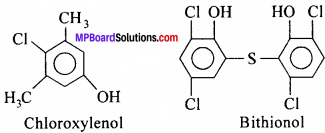
Question 7.
What do you mean by Antibiotics ? Name the first antibiotic.
Answer:
Chemical substances which are produced by mirco-organism and are used to destroy other micro-organism, are called antibiotics. These chemicals checks the life cycle of bacteria and stop reproduction resulting in release from disease. Antibiotics are almost specific for kinds of illness.
The first antibiotic penicillin was discovered by Alexander Fleming in 1928. He was awarded Nobel prize in 1945 for this important discovery. General formula of penicillin is C9H11N2O4S – R. It is a narrow spectrum drug and used in bronchitis, pneumonia, sore throat and abcesses. Before administration, tolerance has to be tested.
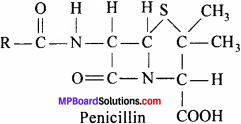
By changing the group R, different penicillin are prepared.
![]()
Question 8.
Write name and formula of some Antipyretic medicines.
Answer:
Antipyretic:
Chemicals used to reduce the body temperature during fever are called antipyretics. These effect the central nervous system of the body. Like paracetamol. Some chemicals function both as antipyretic as well as analgesic like: Aspirin, Paracetamol, Analgin etc. use of these produce sweat and cool the body. Chemical formula of common

Question 9.
Give definition of antihistamine drug with name and uses.
Answer:
These are amines which controls the allergy effect produced by histamines. Histamine is found in all body tissue and is also released in allergic conditions due to which allergic responses such as tissue inflammation, asthma, itching etc. are introduced in the body. Drugs which prevent the production of histamine and fight against the allergy effects are called antihistamines.
Example:
(i) Entergon:
It is used in strong allergic conditions.

(ii) Benadryl
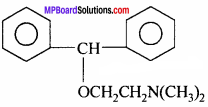
Question 10.
What are the main differences between soap and detergents ? Ans. Differences between Soap and Detergents :
Soap:
- Soaps are sodium salts of higher fatty acids.
- These cannot be used with hard water.
- Their aqueous solution is alkaline in nature.
- These contain oil and are not good cleansing agent.
- These cannot be used for soft and delicate cloth.
Detergents:
- Detergents are sodium salt of alkyl benzene sulphonate.
- These can be used with hard water.
- Their aqueous solution is neutral in nature.
- These do not contain oil and are better cleansing agent.
- These can be used for soft and delicate cloth.
Question 11.
Explain each with an example.
(A) Antibiotics
(B) Analgesic (Pain Killer).
Answer:
(A) Antibiotics:
Chemical substance which are produced by micro-organism and used to destroy micro-organism are called antibiotics. These are of two types:
- Broad spectrum Antibiotic:
Example: Tetracycline, chloramphenicol, Penicil-lin. - Narrow Spectrum Antibiotic :
Example : Niastatin, Penicillin antibiotic medi-cines are used for the treatment of typhoid, whooping cough, Pneumonia.
(B) Analgesic:
Drugs which give relief from pain or reduced pain are called analge-sics. Types and Examples:
- Narcotics: Morphine, Codeine.
- Non-Narcotics: Aspirin, Analgin, Paracetamol.
![]()
Question 12.
What is preservative ? Give the name and formula of any two preserva-tives.
Answer:
A preservative is defined as “A substance added to food, capable of retarding the growth of micro-organism which deteriorate the food within no time’’. The preservative may be natural compounds such as sugars, salt, acids, etc. as well as they may be synthetic i.e. Sodium benzoate.
Example:
- Vinegar or acetic acid : CH3 COOH
- Sodium benzoate: C6H5COONa.
Chemistry in Everyday Life Long Answer Type Questions
Question 1.
Write short notes on:
- Antifertility drugs
- Detergents
- Antacids
- Sedatives
- Sulpha drugs.
Answer:
1. Antifertility drugs:
Drugs which are used to check pregnancy in women are called antifertility drugs. Actually, these drugs control the female menstrual cycle and ovulation. The antifertility agent in these drugs are steroids and these drugs are used in the form of oral pills. A mixture of synthetic estrogen and progesterone derivative are used as birth control pill. These are more effective than the natural hormone. Ethynylestradiol and norethindrone are the content of common contraceptive pills.

2. Detergents:
Unsaturated hydrocarbon of ethylene type containing 10 to 18 carbon atoms on treatment with sulphuric acid forms organic acid. Sodium salt of organic acid have moisture absorbing and purification property. This compound is called synthetic detergent. Example: Sodium w-dodecyl benzene sulphonate, Sodium n – dodecyl sulphate.

CH3 – (CH2)10 – CH2 – SO4Na+
Sodium n-dodecyl sulphate
Synthetic detergents have two parts:
- A long chain of hydrocarbon which is hydrophobic (Water repellent).
- Small ionic chain is hydrophilic (Water attracting).
Ionic chain is generally of sulphonate (SO3Na) or sodium sulphate (SO4Na). Detergents are surface active compounds which decreases surface tension of water. When these compounds are dissolved in water they scatter dirt particles leaving the surface clean.
Properties of detergents:
Detergents are superior to soap.
1. Detergents can be used in hard as well as soft water because they do not form insoluble salt with calcium and magnesium ions of hard water while soap cannot be used in hard water.
2. Aqueous solution of detergent is neutral. Therefore, detergents can clean soft fibres without damaging them. Soap solution is alkaline due to hydrolysis and is harmful for washing soft fibres.
Uses of detergents:
Detergensts act as cleansing agent. Like soap it can be used for cleaning cotton, woollen, silky and synthetic fibre cloth and for cleaning other domestic items.
![]()
3. Antacids:
Substance which remove the excess acid in the stomach and raise the pH to appropriate level are called antacid Calcium carbonate, Sodium bicarbonate, Magnesium hydroxide or Aluminium hydroxide is used in the form of aqueous suspension or tablets to treats hyperacidity. These substances react with excess hydrochloride acid and neutralizes it partially. Nowadays Omeparazole and Lansoparazole are prescribed as antacids.
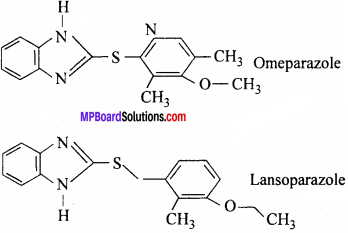
4. Sedatives:
These are given to those patients who are violent and mentally agitated.
Example:
- Equanil
- Barbituric acid.

5. Sulpha drugs:
Like antibiotics, sulpha drugs are used to kill micro-organism. These are prepared in laboratory. Sulphadiazine, sulphanilamide, sulphathiazole, sulpha guanidine, etc. are important sulpha drugs.
Question 2.
Write notes on the following:
- Tranquillizers and Hypnotics
- Antidepressant.
Answer:
(i) Tranquillizers:
Tranquillizers are the chemical substances which affect higher centers of central nervous systems and reduce anxiety and tension. Tranquillizers are also called psycho-therapeutic drugs. These drugs make the patient passive temporarily so that emotional distress or depression is reduced. The patient restores confidence. These drugs if taken for long-time make the person habitual. Luminal, Barbituric acid, seconal, equanil, etc. are the drugs of this class. These are components of sleeping pills.
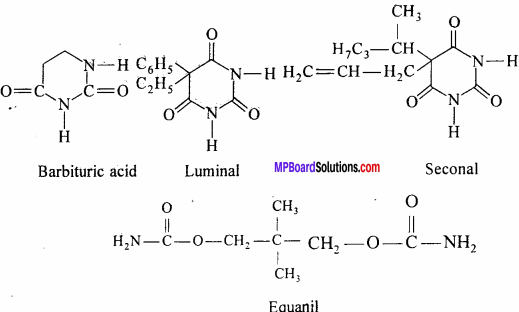
(ii) Anti-depression:
These are given to patient for boosting their morals in the stage of acute depressions. Some mood elevator drugs are vitellin, methadone, cocaine, etc. These act on the central nervous system. Person becomes healthy by its use and develop confidence. These should be taken by the advice of doctor. Tophrenil is one such medicine. The amphetemin group of medicine help to upraise the mental level. Its com-mon example is benzedine.

Question 3.
Give one example of Acidic dye and Basic dye.
Answer:
Acidic dye: In these, acidic group like phenolic, sulphonic (SO3H) are in the form of sodium salts. These colour animal fibre like wool, silk etc. Example: orange I and II.

- Acidic dye: Methyl orange , Methyl red.
- Basic dye: Malachite green, Aniline yellow.
Question 4.
Write example of the following chemicals:
- Two Analgesics
- Two Antiseptic
- Two Antiseptic chemical
- Two Anti-biotic
- Two Anaesthetic
- Two Sulpha drug
- Two Rocket propellant
- Two use of chloramphenicol antibiotic.
Answer:
- Two Analgesic: (i) Morphine, (ii) Aspirin.
- Two Antiseptic: (i) Dettol, (ii) Bithional.
- Two antiseptic chemical: (i) Boric acid, (ii) Gention violet.
- Two Antibiotic: (i) Terramycin, (ii) Streptomycin.
- Two Anaesthetic: (i) Cyclopropane, (ii) Pelledyne.
- Two sulpha drug: (i) Sulphonide, (ii) Sulphadyne.
- Two rocket propellant: (i) Polyurethane, (ii) Ammonium perchlorate.
- Two use of chloramphenicol antibiotic: (i) In Typhiod, (ii) High fever and diarrhoea.